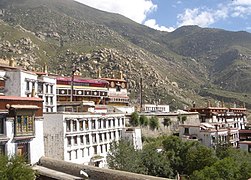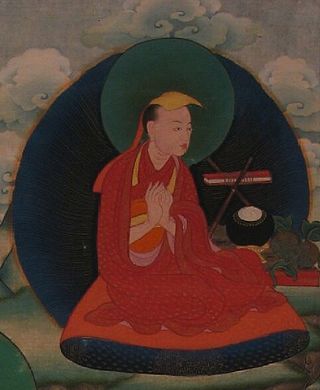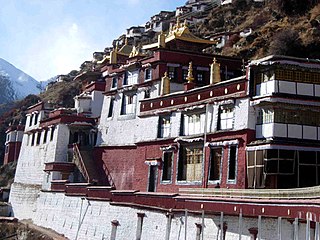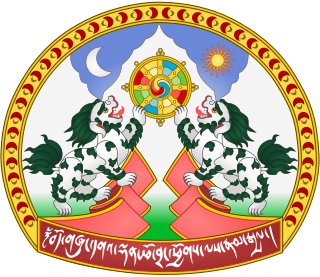| Part of a series on |
| Tibetan Buddhism |
|---|
 |
This is the list of Tibetan monasteries of Tibetan Buddhism. [1]
Contents
| Name | Location | Tradition | Established | Destroyed | Note |
|---|---|---|---|---|---|
| Alchi | Ladakh | Gelug | 11th century | ||
| Badekar Monastery | Bugat, Inner Mongolia Autonomous Region | Gelug | 1749 | ||
| Chagri Monastery | Bhutan | Kagyu | 1620 | ||
| Chaksam Cho Ri | Chushul, U-Tsang | 14th century | Destroyed in 1959 | from Chaksam Bridge diagram made in 1878 | |
| Dorje Drak | Lhoka | Nyingma | 1400, 1720, 1960s in India | 1717, 1960s | One of the six "Nyingmapa mother monasteries." |
| Drepung | Lhasa | Gelug | 1416 | Home monastery of the Dalai Lama and founded by Jamyang Choje. Drepung was historically the largest monastery in Tibet as well as the largest in the world until the annexation of Tibet by the People's Republic of China | |
| Drigung | Lhasa Prefecture | Kagyu | 1179, 1980s | 1960s | |
| Drongtse Monastery | Tsang | Gelug | |||
| Dzogchen | Kham | Nyingma | 1684 | One of the six "Nyingmapa mother monasteries." | |
| Ganden | Lhasa Prefecture | Gelug | 1409 | 1959, 1966 | Seat of the Ganden Tripa. Founded by Tsongkhapa in 1409. |
| Gonchen Monastery | Kham | Sakya | 1729 | ||
| Gongkar Chöde | Lhokha | Sakya | 1464 | ||
| Gyumay and Gyuto Lower and Upper Tantric Colleges | Tsang | Gelug | 1433 and 1475 | [2] | |
| Hemis | Ladakh | Drukpa | 1672 | ||
| Jokhang Temple | Lhasa | Gelug | 652 | Severely Damaged by People's Liberation Army in March, 1959 | Lhasa main temple. Said to have been built by King Songtsen Gampo in 647; a major pilgrimage site. |
| Jonang Phuntsokling Monastery | Tsang | Jonang | 14th century | ||
| Kardang | Lahaul | Drukpa | 12th century | Main monastery in Lahaul. | |
| Karma Gön Monastery | Kham | Kagyu | 1147 | Seat of the 1st to the 7th Tai Situpa | |
| Katok | Garze | Nyingma | 1159 | One of the six "Nyingmapa mother monasteries". | |
| Keru Temple | Ü | Nyingma | mid-8th century | ||
| Key Monastery | Lahaul and Spiti district, Himachal Pradesh | Gelugpa | 11th century | ||
| Kharchu Monastery | Lhokha | Nyingma | 16th century | ||
| Khomthing Monastery | Lhokha | ||||
| Khorshak Temple | Western Tibet | ||||
| Kirti Gompa | Amdo | Gelug | 1472 | ||
| Kumbum Monastery | Amdo | Gelug | 1583 | ||
| Labrang Monastery | Amdo | Gelug | 1709 | Was founded in 1709 by the first Jamyang Zhaypa, Ngawang Tsondru. | |
| Lhuntse Dzong | Bhutan | Nyingma | 1654 | The 14th Dalai Lama arrived at Lhuntse Dzong on 26 March 1959, on his way to exile in India. | |
| Magur Namgyal Ling | Amdo | Gelug | 1646 [3] | ||
| Menri | Ü | Bön | 1405 | 1386, 1966 | |
| Menri Monastery | Tsang | ||||
| Mindrolling | Lhokha | Nyingma | One of the six "Nyingmapa mother monasteries." | ||
| Nalendra Monastery | Penpo | [4] | |||
| Namdzong Nunnery | Amdo | ||||
| Namgyal Monastery | Lhasa | ||||
| Nangshi Monastery | Ngaba, Amdo | ||||
| Narthang Monastery | Tsang | ||||
| Nechung Temple | Lhasa | ||||
| Ngor Temple | Ü | Sakya | 1429 | 1959 [5] | |
| Nyethang Drolma Lhakhang Temple | Ü | ||||
| Pabonka Hermitage | Lhasa | Gelug | 7th century | Independent before 1959, has belonged to Sera since 1980. | |
| Gyantse Palkor Chöde Monastery (Palcho Monastery) | Tsang | Gelug, Sakya, Kadam | 1428 | ||
| Palpung | Derge | Kagyu | 1727 | Founded by the 8th Situ Panchen, Seat of the Tai Situpa and Jamgon Kongtrul. | |
| Palyul | Palyul | Nyingma | One of the six "Nyingmapa mother monasteries". Other branch "Namdroling Monastery" established by Penor Rinpoche in India, in 1963 | ||
| Pemayangtse Monastery | Sikkim | Nyingma | 1705 | ||
| Pomda Monastery | Baxoi | ||||
| Punakha Dzong | Bhutan | Drukpa | Winter home of the Central Monk Body | ||
| Ralung Monastery | Tsang | ||||
| Ralung | Drukpa | Seat of the Gyalwang Drukpa | |||
| Ramoche Temple | Lhasa | ||||
| Rato Dratsang | Karnataka | Gelug | Formerly on the outskirts of Lhasa, but now re-established in south India. | ||
| Ratö Monastery | Ü | ||||
| Reting | Ü | Gelug | |||
| Riwoche | Kham | Kagyu | Seat of the Taklung Kagyu lineage. | ||
| Rongbuk | Basum Township | Nyingma | 1902 | ||
| Rongwo Gönchen Monastery | Amdo | ||||
| Rumtek Monastery | Sikkim | Kagyu | 18th century | ||
| Sakya Monastery | Tsang | Sakya | Seat of the Sakya Trizin. | ||
| Samye Monastery | Ü | 775 - 779 | |||
| Samye | Nyingma | First monastery in Tibet, established by Padmasambhava and Shantarakshita. Heinrich Harrer in 1982 flew over "Samye; it was totally destroyed. One can still make out the outer wall, but none of the temples or stupas survives." [6] | |||
| Sekhar Guthok Monastery | Lhokha | [7] 1950 photo of Sekhar Gutog (sras mkhar dgu thog) monastery in Lhodrag by Hugh Richardson. Founded by Milarepa in the 11th century [8] | |||
| Sanga Monastery | Lhokha | ||||
| Sera | Lhasa | Gelug | One of the largest monasteries in Tibet, containing numerous colleges. Founded by Chöje Shakya Yeshe. [[:|Photo of smashed statues pieces at Lhasa's Sera Monastery destroyed by the Communist Chinese after 1959 flight of the 14th Dalai Lama to exile in India.]] | ||
| Shalu | Tsang | Sakya | |||
| Shechen | Kham | Nyingma | One of the six "Nyingmapa mother monasteries". | ||
| Simbiling Monastery | ... | ||||
| Spituk | Ladakh | Gelug | |||
| Surmang Monastery | Kham | 1988 | |||
| Surmang | Kagyu | Seat of the Trungpa tülkus. | |||
| Tabo | Spiti | Gelug | Largest monastery in Spiti. | ||
| Taklung Monastery | Ü | ||||
| Taktsang Monastery | Dzoge, Amdo | ||||
| Tamzhing Monastery | Bhutan | Nyingma | 1501 | ||
| Tashichho Dzong | Thimphu | Drukpa | Houses the Central Monk Body in summer. | ||
| Tashilhünpo | Tsang | Gelug | Seat of the Panchen Lama. Founded by Gyalwa Gendün Drup. | ||
| Tawang Monastery | Tawang District, Arunachal Pradesh | Gelug | 1681 | The monastery is the second-largest in Asia. [9] | |
| Thikse Monastery | Ladakh | Gelug | 15th century | ||
| Tholing Monastery | West Tibet | ||||
| Tibet Institute Rikon | Rikon, Switzerland | Nyingma | Since 2007, the monastery comprises representatives of all four great traditions : Nyingma, Kagyu, Sakya and Gelug. | ||
| Tingri Monastery | Tsang | ||||
| Tradruk Temple | Lhokha | Gelug | The largest and oldest monastery in the Yarlung Valley. Said to have been built by King Songtsen Gampo. | ||
| Trathang Monastery | Lhokha | ||||
| Tsandan Monastery | Nagchu | ||||
| Tsaparang Monastery & Palace Complex | Western Tibet | ||||
| Tsethang Monastery | Lhokha | ||||
| Tsö Monastery | Amdo | ||||
| Tsozong Gongba | Nyingma | ||||
| Tsuglagkhang Temple | Dharamshala, Himachal Pradesh | Current residence of the 14th Dalai Lama. | |||
| Tsurphu | Ü | Kagyu | Seat of the Gyalwa Karmapa. | ||
| Yama Tashikyil | Rebkong, Amdo | ||||
| Yarchen Gar | Nyingma | 1985 | Largest monastery in the world +10000 monks. | ||
| Yarlung Sheldrak | U-tsang | Gelug | 18th century | "Yarlung Sheldrak is a monastic community that first developed around a Padmasambhava meditation cave, possibly as early as the eighth century. It was converted to the Geluk tradition in the nineteenth century." [10] | |
| Yemar Temple | Tsang | ||||
| Yerpa | Gelug | 600–700 | 1959 | Famous meditation site of King Songtsen Gampo and Padmasambhava; 300 monks lived here in 1959. | |
| Yonghe Temple | Beijing | Gelug | 1700s | National centre of Lama administration during Qing dynasty | |
| Yungdrungling Monastery | Tsang | [11] |



















